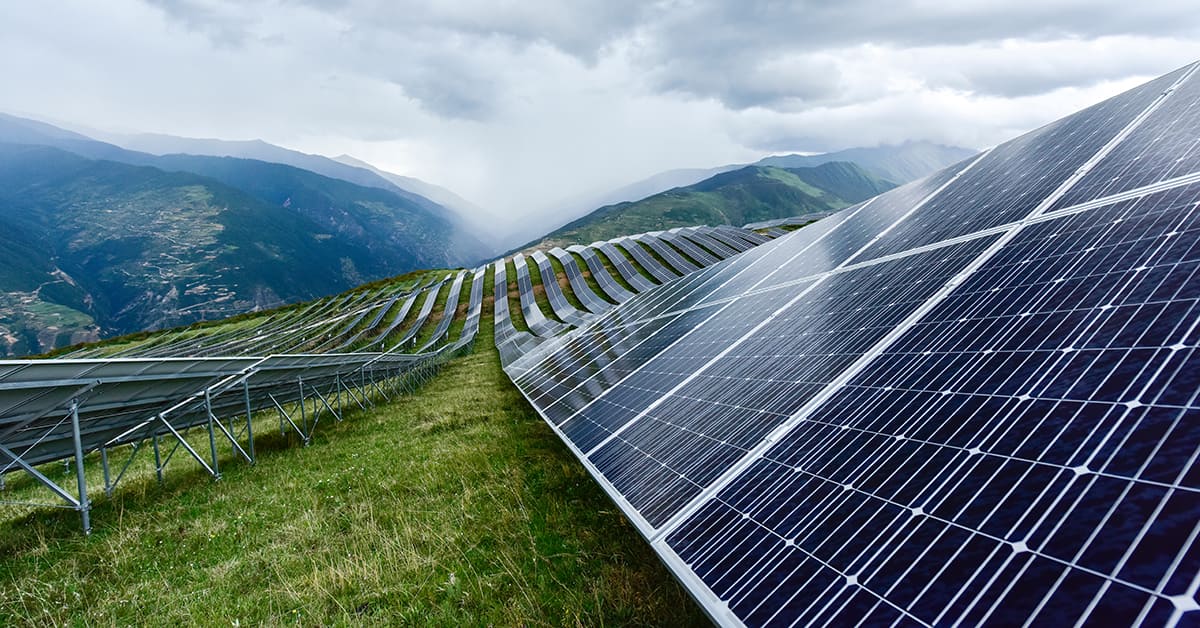Reducing carbon emissions needs a tandem public and private effort.

An unsettling realization is emerging throughout finance: The quest to stop economic activity from rendering the planet unfit for human habitation will require a profound—and profoundly expensive—transformation.
And the only thing more expensive than making this transition could be not making it. In 2021, Hurricane Ida ravaged the southern and northeastern US to the tune of at least $65 billion and perhaps as much as $95 billion. In Brazil, the loss of hydroelectric capabilities during extreme droughts sent power prices soaring. Meanwhile, railroad management costs have risen in California because of frequent and massive wildfires. These are a sprinkling of examples that can be found around the world.
“The scientific consensus is increasingly certain that human activity is causing climate change and contributing to this increasing trend of frequency and severity of natural disasters,” says Dennis Sugrue, senior director and Global Insurance ESG lead for S&P Global Ratings.
In the short term, many companies have turned to catastrophe bonds, or “CAT bonds,” which pay out in the event of a natural disaster. CAT bond issuances hit a record high in 2021, according to Moody’s. “The frequency and severity of natural disasters have been increasing over the last 30 years,” notes Sugrue, “contributing to a substantial rise in the number of insured losses.” Expect premiums for such products to soar, say the authors of a 2020 Bank of France study, who calculated that natural-disaster insurance premiums will have to be 130% to 200% higher by 2050 for insurers to be able to compensate policyholders. That, Sugrue says, implies an average annual rate increase of 2.8 to 3.7%.
Meanwhile, across the financial world—banks, insurers, investors, public agencies, CFOs and a growing array of third-party raters—the business risks from environmental stresses are being assessed and projected with increasing detail, focus and comprehensiveness. A troubling picture emerges: The cost to mitigate the climate crisis and associated fallout is estimated to run between $100 trillion and $150 trillion by 2050. Who is prepared to pay such a bill?
“Only mainstream private finance can match the scale of climate action needed for the net-zero transition, including meeting investment needs in emerging markets and developing countries,” Mark Carney, the former governor of the Bank of England, said in April. “We cannot get to net zero through niche efforts; we must green the entire financial system, along with every sector of our economies.”
Carney is now UN Special Envoy for Climate Action and Finance and the leading promoter of the Glasgow Financial Alliance for Net Zero (GFANZ), a club of 450 banks and insurance companies spread across 45 countries, collectively managing over $130 trillion. This alliance, launched in April 2021, offers a grand vision of $130 trillion in private capital to be invested in line with net-zero principles. But the club holds members to no specific requirement.
“Clearly, that $130 trillion is an aspiration we might get to one day,” comments Jonathan Bailey, head of ESG Investing at investment manager Neuberger Berman, a GFANZ member. “That is not how most portfolios are being managed today.”
Others contend the public hand remains fundamental, to guide private actors by regulation. “Any sort of positive statement on this is good, given how few statements we have; but I would like to see it translated into specifics,” says Raghuram Rajan, professor of finance at the Chicago Booth School of Business, former governor of the Reserve Bank of India and former chief economist at the International Monetary Fund. “I worry that numbers like the $130 trillion undermine the seriousness of this. Anybody who knows numbers knows that $130 trillion is not available.”
The Limits of Volunteerism
Many governments have to date been content to leave mandates aside. In 2015, the Financial Stability Board, for example, launched its Task Force on Climate-related Financial Disclosures in response to a call from G20 governments. But global industry-led vehicle merely encourages voluntary disclosure of environmental risks. No surprise, then, that a November 2021 study by the European Central Bank (ECB) noted that no institution under its watch was close to meeting the central bank’s expectations for climate strategy, with excessive risks from exposure to fossil fuel, energy production, automotive, steel and aviation sectors.
Meanwhile, Frank Elderson, executive board member of the ECB, notes in a November blog post that while around half the 112 institutions overseen by the Frankfurt-based central bank are “contemplating” setting some specific exclusion targets for certain segments of the market, “only a handful of them mention actively planning to steer their portfolios on a Paris-compatible trajectory.”
“Ultimately, greening the economy is a political decision,” says Rajan. “It’s a very important and very necessary decision.”
Investors do not seek to pay tabs, but to earn profits; and incentives are accordingly aligned. A typical ESG review of an asset is designed to assess risk for the purpose of setting correct prices, not to avoid involvement. “In the financial services industry, when people talk about climate risks, they don’t mean risk to the planet; they mean risks to their portfolio,” explains Tariq Fancy, BlackRock’s first CIO for Sustainable Investing, now a vocal advocate for more aggressive climate change mitigation efforts by the financial sector. “We’re not trying to stop Miami from getting wrecked by climate change. We’re trying to get our money out before it hits.”
In the corporate sector, the same dynamics are at play. Consider the UN COP26 agreement to phase out internal combustion engines by 2040; Volkswagen and Toyota are among those that have not signed on. “For incumbents who’ve got to change their business models over the next 10-plus years, it is going to be highly disruptive,” says Bailey. “There will be winners and losers.”
Yet it’s not that these industrial giants aren’t trying. In fact, analysis by Reuters pegs Volkswagen as an industry leader in battery technology and electric-vehicle development. And in the wake of COP26, Toyota announced a massive ramp-up of its electric-vehicle efforts, with a boost in investment to 8 trillion yen ($70 billion) and newly accelerated deadlines for electric models. “As policies became clear we thought about our own policies and came up with this new figure,” Toyota CEO Akio Toyoda said at a briefing in mid-December, giving a nod to government commitments that came out of COP26. Further, within 15 years the company will sell only zero-emission cars in Europe, due to the EU’s forward-thinking policies.
Simply put corporates and banks alike are grappling with the need for change that is not only radical, but rapid, with no single clear and obvious path. “Under any scenario, profits are going to have to get hurt in the near term; because you have entire business models that have been built off exploiting the public good,” says Fancy.
Guidance and Regulationd
Central banks and governments—even the laggard US—are slowly taking a more active role. The US Federal Reserve finally joined the Network for Greening the Financial System, an international group of regulators exchanging information and ideas, in December 2020. Then last October, US Treasury Secretary Janet Yellen told the Financial Stability Oversight Council that “climate change is an emerging and increasing threat to US financial stability.” Yellen was presenting a Treasury-led report that determined that regulators should use scenario analysis to create predictive risk-management tools and assess systemic risk. The Bank of England and Bank of France have already tried to assess how balance sheets and the broader economy would be impacted by different economic scenarios arising under varying degrees of planetary warming.
So far, no banking regulator has directly tied bank capital requirements to the results of such studies, but this is likely to happen. The ECB, for example, said in its November report that lenders might eventually be required to hold a higher level of capital based on their exposure to climate risks.
Government regulation may come with incentives as well as mandates. China, the world’s largest emission issuer in total (although the US generates far more on a per capita basis), unveiled a plan in November to help financial institutions provide loans to firms that specialize in developing and adopting clean energy. Banks are eligible to borrow 60% of qualifying loans from the People’s Bank of China at an interest rate of 1.75%. The plan could bring an estimated $1 trillion investment in clean energy projects annually.
The negotiation of climate change deals should not be overlooked—it is relevant for final success, according to the Booth School’s Rajan. “Many financial institutions will be pressed to stop funding coal, and that will be in part because of outside pressure,” he says. “I do worry that, in those situations, there will be a sort of asymmetric treatment. The countries that already have coal plants or can finance them themselves will get a free pass, while the developing countries like Uganda and Tanzania that may want to use coal will simply not get the financing to do it.” Offering energy-hungry emerging countries incentives would be fairer, he adds, “The stoppage of financing is brutal.”
As in health care, public money often supports foundational research that builds whole new realms of green solutions. Many companies are counting on technologies that have not been fully proven yet. The world’s largest cement companies, which have committed to reaching net zero by 2050, for example, plan to get there with carbon capture and storage (CCS). But the technology just isn’t ready. “We don’t have CCS operating at scale or in a cost-effective way,” says Neuberger Berman’s Bailey. “So, the capital that we manage on behalf of our clients is not necessarily going to be able to take the risk. You’re going to have a role for governments to provide support for some of these new technologies.”
Policy can also encourage support for such invention from the private sector. “To be clear, governments have to be the catalyst,” says Fancy. “But private markets must do the heavy lifting because the private sector has most of the jobs and most of the capital in the economy. So, you need big business to do the right thing and financial markets must allocate lots of private capital towards renewable power and breakthrough technologies.”
According to Fancy, only a combination of public carrots and sticks—taxpayer-financed incentives and government-mandated penalties—will drive green investment. “It’s a little bit like moving from good sportsmanship on a football field to where the referees will give players a red card if they don’t do the right thing,” he says. “Ultimately, businesses should be happy with that, because they’re claiming they’re going to do the right things. What worries me, however, is that … the incentives are misaligned.”
Green Revolution
Noted environmental activist and former US vice president, Al Gore noted in the Washington Post that humanity is in the early stages of a “sustainability revolution” that combines “the magnitude of the industrial revolution but the speed of the digital revolution.” This suggests the need for a profound change in the mindset of citizens, C-suite denizens, politicians and financiers everywhere.
Private sector or public sector, there are no angels. “National governments have not on a global basis committed to net zero by 2050,” Bailey notes, pointing to India (by 2070) and China (by 2060).
Bailey believes that “the private sector is in fact moving ahead of many governments progress on climate.” The green revolution “is very significant for chief financial officers,” he adds. “It means that you’ve got to rethink your current allocation approach, to build in climate transition to those plans at the core and to have the flexibility around different pathways and scenarios.”
Fancy sees a flaw in the way current incentive structures favor relatively short-term thinking in both public and private sectors: “Whether it’s business leaders who are getting paid in the next few years or politicians who are getting reelected in the next few years, everybody has an incentive to sort of sell a pipe dream; because they don’t want to actually do expensive changes today that will not pay out for 20 or 30 years.”
So far, most of what has come out of voluntary efforts or upscale meetings such as Davos or COP26 have been pledges that typically lack critical specifics about how, how much, and when exactly. It is easy to talk about sustainability in 2050; harder to map a path to it. As Neuberger Berman’s Bailey points out: “There’s a lot of gaps in the plans that have been put forward.”



